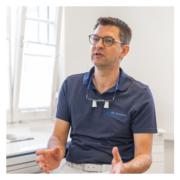“I’m totally won over by the vhf dental milling machines”
Dentist Dr. Tim Wiesner talks about the new vhf EASE CLASS
The decision to invest in the E4 and E5 dental milling machines wasn’t difficult for Dr. Tim Wiesner. Since purchasing the two devices in the new vhf EASE CLASS product series, they’ve been operating almost every day. In our conversation at his Tübingen dental practice, he explains why he chose the two vhf machines and explains his route to digital chairside production.
Dr. Wiesner, how would you describe what the dental profession means to you personally?
On the one hand, the combination of fine motor skills and extremely delicate procedures when treating dental issues. On the other, the multi-faceted and varied approach to patients and the wide spectrum of treatment options. Achieving excellent results using modern treatment methods brings me so much enjoyment and fulfillment every day.
Meanwhile, the word is out among your patients that you can produce dentures within a day. Which CAD/CAM manufacturing solution did you choose?
I’m currently working with the TRIOS 3 scanner, and mainly use Exocad DentalCAD for the design process. I also use the Splint Studio by 3Shape to generate splints and the TRIOS Design Studio to design crowns. I use two vhf machines as milling devices: the E5 for milling discs and the E4 for blocks.
So all the individual components you use come from different manufacturers?
Correct. I didn’t want to purchase a closed system solution. It was important to opt for an open system that enabled me to use components from other manufacturers, so I’m not bound to a single manufacturer. It quickly became clear that this is only possible with machines from vhf. That’s why my specialist dealer recommended vhf to me.
You have used the E4 and E5 since day one. How satisfied are you with the two dental milling machines in your everyday practice?
I bought the machines in March this year and they’ve been operating almost every day. I’m delighted with the application. I’ve had no problems whatsoever, and the machines perform exactly as expected: they produce excellent results in a very manageable timeframe.
Dr. Wiesner, when did you decide to go down the route of digital dentistry in your practice?
I was a regular visitor to trade fairs and kept an eye on how CAD/CAM technology was developing overall. I also did a lot of research on the subject in the specialist literature. The next step was obvious when I realized that intraoral scanners were no longer inferior to conventional impressions and also because I’m fascinated by new developments. I first decided to purchase an intraoral scanner and never regretted it for a moment. After just a few weeks, we noticed how this type of device was saving us a vast amount of time. It also made the procedures in the practice so much more efficient. These positive experiences quickly made me want to go down the path of digital manufacturing and to produce crowns, inlays and occlusal splints in-house.
You finally decided to buy the E4 and E5 dental milling machines from vhf and other items for digital production. Have these investments paid off?
Absolutely. We carried out the relevant cost-benefit analysis to evaluate the acquisition costs, license fees, etc. and very quickly identified the cost savings. The overall investment costs are also very reasonable. I was also able to take advantage of the funding from the state of Baden-Württemberg in the form of the digital bonus, which is granted to companies that invest in expanding their digitalization. That was a great incentive to embark on digital dental technology and to purchase the devices. We’re already planning the next upgrade, and we will be replacing the TRIOS 3 scanner with the new TRIOS 5 model.
What specific benefits have you gained from introducing CAD/CAM technology in your practical laboratory?
Dentistry-in-One-Day, or to put it simply: dentures in a day. This is becoming increasingly common, and demand is now growing. I’m now able to prepare the dentures in the morning and fit the dentures in the afternoon – without compromising on quality. This is a huge advantage. The same principle also applies to splints, and overall we save costs and time.
And why did you choose the E4 and E5 from vhf?
I was immediately drawn to the open technology demonstrated by vhf. The machines represent enormous advantages for individual practices: they are easy to use, cover a wide range of indications and materials and all without the use of compressed air. Then of course there are the investment costs and the innovation and technology behind the system. I’m totally won over by the vhf dental milling machines: from the performance to the costs and right to the end result, and ultimately that’s what counts. The EASE CLASS covers all the requirements for your own practice.
How did you ensure the seamless integration of CAD/CAM technology into your existing treatment process?
We made sure we took our time, and initially worked in parallel with our existing processes. I had the first ten or twenty crowns made in the laboratory, while simultaneously producing them myself in-house, which enabled an accurate comparison with the two production results. This helped me to quickly find out which parameters I had to recreate in the CAD software and what I needed to focus on in the design process. Only when I could discern almost no visible differences between my in-house crowns and the crowns from the lab did we start using them for our patients.
What was the reaction of the dental laboratory you work with when it learned you were now making your own dentures?
You can imagine the dental technicians were somewhat doubtful and also skeptical as to whether the work we could produce in-house would even come close to their results. But I quickly dispelled any doubts, and I think transparent communication was essential in this respect. I explained that I wouldn’t take the work away from them and would only produce small orders in-house that would be overly time-consuming for a lab. The dental technicians really understood, and in no way consider my practice laboratory as competition, because they know there’s no substitute for an experienced dental technician. In any case, as a dentist, I can’t and don’t want to carry out large, complex projects in-house; these require the expertise and skill of a technician. They themselves also had no qualms about my two milling machines, because they know vhf and use vhf dental milling machines from their own lab.
Let’s have a glimpse into the future: How do you think in-house manufacturing in dental practices will develop going forward?
I’m convinced that chairside or in-house production will increase enormously in the future. In addition to the many advantages we’ve been discussing, the technology helps with the shortage of skilled workers. As in all sectors today, hiring new employees and dental assistants in dental practices and dental technology laboratories is a growing problem, which means that production times in the labs are longer owing to the limited capacities. It’s a huge advantage for dentists to make the dentures in a time-efficient process, particularly for small and less complex orders.
To conclude, what advice would you give to other dentists who are currently exploring the topic of digital dentistry?
First, I would start with an intraoral scanner and then select the appropriate machines according to your requirements: that’s the simplest way. I recommend that dentists consult their specialist colleagues and exchange ideas about digital manufacturing. It also makes sense to approach retailers and manufacturers themselves for advice and a demonstration of the various devices. A number of workshops and seminars are available that provide a good overview and detailed information.
About Dr. Tim Wiesner
Dr. Tim Wiesner studied dentistry at the universities of Freiburg and Tübingen. He founded his own dental practice in September 2016, and has eight employees.



